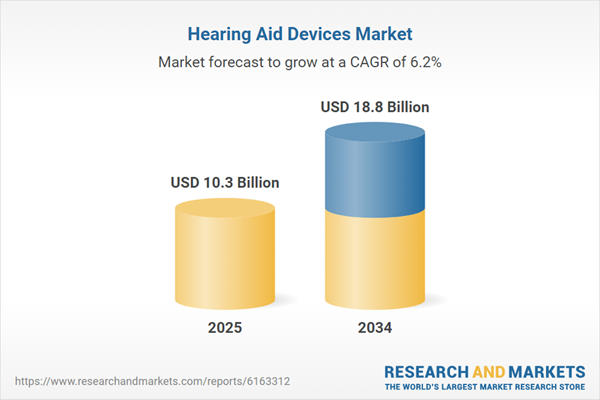Hearing Aid Devices: Introduction
Hearing aid devices are developed with the use of advanced technologies to help people with hearing disorders. These technical solutions are uniquely designed to enhance hearing ability and treat hearing loss. These devices amplify the sound and enhance the overall listening experience of people who are suffering from hearing disorders due to occurrence of some disease or due to some unfortunate life events.Hearing aid devices come in several different types, including behind-the-ear (BTE), in-the-ear (ITE), and in-the-canal (ITC) devices, among others. These devices are embedded with microphones, amplifiers, and speakers to process and deliver sound effectively to the user. The market for hearing aid devices is driven by several key factors, including the increasing prevalence of hearing loss, technological advancements, and changing consumer preferences. This presence of hearing aid devices has revolutionized the way people with hearing loss communicate and interact with other people in public or at home with friends and family.
Global Hearing Aid Devices Market Analysis
The market for hearing aids has recorded substantial technological advancements, leading to the development of more advanced and complex devices. These advancements in hearing aid devices include digital signal processing, wireless connectivity, and artificial intelligence (AI) integration. These technologies enhance sound quality, comes with active noise cancellation feature, and provide personalized hearing experiences. The rising demand for these technologically advanced products has been aiding the global hearing aid devices market growth.The increasing awareness among people about their appearance and aesthetics has also been propelling the market growth. People want their hearing aid devices to be updated with today's lifestyle and want them to appear aesthetic. The rapidly increasing demand for hearing devices to be designed and developed in smaller versions as they will feel more comfortable, convenient and aesthetic has been continuously contributing to the market growth. This trend is highly contributing to the global hearing aid devices market expansion.
Global Hearing Aid Devices Market Segmentations
Hearing Aid Devices Market Report and Forecast 2025-2034 offers a detailed analysis of the market based on the following segments:Market Breakup by Product Type
- Hearing Aid Devices
- Hearing Implants
Market Breakup by Device Type
- Prescription-Based
- Over the Counter
Market Breakup by Type of Hearing Loss
- Sensorineural
- Conductive
Market Breakup by Technology
- Conventional Hearing Aids
- Digital Hearing Aids
Market Breakup by Patient Type
- Adults
- Pediatrics and Children
Market Breakup by Distribution Channel
- Online
- Offline
Market Breakup by Region
- North America
- Europe
- Asia Pacific
- Latin America
- Middle East and Africa
Global Hearing Aid Devices Market Overview
The increasing prevalence of hearing loss and the growing demand for advanced hearing aid devices is primarily driving the growth of the market. Hearing aids are medical devices designed to improve hearing ability and enhance the quality of life for individuals with hearing issues or disorders. Other factors aiding the growth include the rising geriatric population, increased awareness about hearing health, and technological advancements. The key players in the market are constantly putting efforts in developing more advanced hearing aid devices that offer improved sound quality, better comfort, and enhanced user experience.The market for hearing aid devices is expected to keep growing in coming years driven by the technological advancements and evolving consumer preferences along with the manufacturers trying to bring innovative hearing solutions in the market.
Global Hearing Aid Devices Market: Competitor Landscape
The key features of the market report include patent analysis, grants analysis, clinical trials analysis, funding and investment analysis, partnerships, and collaborations analysis by the leading key players. The major companies in the market are as follows:- Sonova Holding AG
- Demant A/S
- GN Store Nord A/S
- Cochlear Limited
- Starkey Hearing Technologies
- Rion Co., Ltd.
- WS Audiology A/S
- Medtronic Plc.
- Amplifon SpA
- MED-EL
- Eargo, Inc.
- Horentek
- Nano Hearing Aids
This product will be delivered within 3-5 business days.
Table of Contents
Companies Mentioned
- Sonova Holding AG
- Demant A/S
- GN Store Nord A/S
- Cochlear Limited
- Starkey Hearing Technologies
- Rion Co., Ltd.
- WS Audiology A/S
- Medtronic Plc.
- Amplifon SpA
- MED-EL
- Eargo, Inc.
- Horentek
- Nano Hearing Aids
Table Information
| Report Attribute | Details |
|---|---|
| No. of Pages | 350 |
| Published | July 2025 |
| Forecast Period | 2025 - 2034 |
| Estimated Market Value ( USD | $ 10.3 Billion |
| Forecasted Market Value ( USD | $ 18.8 Billion |
| Compound Annual Growth Rate | 6.2% |
| Regions Covered | Global |
| No. of Companies Mentioned | 13 |









